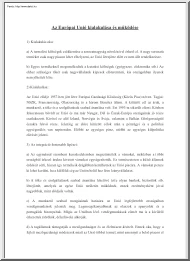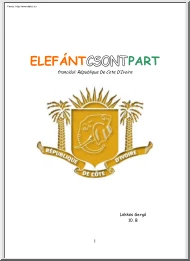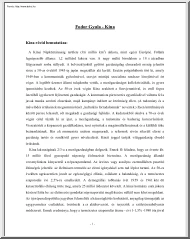Datasheet
Year, pagecount:2015, 2 page(s)
Language:English
Downloads:2
Uploaded:September 06, 2017
Size:1 MB
Institution:
-
Comments:
Attachment:-
Download in PDF:Please log in!
Comments
No comments yet. You can be the first!Most popular documents in this category
Content extract
Source: http://www.doksinet Assets Creation WFP Myanmar Context: Myanmar, with an estimated population of 51.4 million, is one of the poorest and least developed countries in the world, ranking poorly 150th out of 187 countries in 2014 UNDP’s Human Development Report. More than 13 million people or 26 percent of Myanmar’s population live below the poverty line. Close to three million people are considered food poor, spending a high percentage of their limited income on food with a restricted diet that does not meet all their consumption needs. Almost 70 percent of population lives in rural areas and their main livelihood is agricultural production. Myanmar has significant agricultural potential, but has minimal adequate infrastructure, affecting market accessibility and agricultural production. At the same time, the country is prone to natural disasters. The coastal regions are exposed to cyclones, tropical storms, tsunamis and flash floods. While the hilly regions suffer from
landslides and earthquakes, the Dry Zone in the central Myanmar is prone to drought. Recurrent climate shocks significantly jeopardise local development processes and put additional strains on limited livelihood resources, particularly in transhumant and agro-pastoral communities. The existing national response mechanisms are unable to tackle numerous complex food security challenges in the country. Poor safety net coverage leaves the majority of the population particularly vulnerable to the effects of socioeconomic and environmental shocks. Response: Under the WFP’s current protracted relief and recovery operation, marginal and vulnerable population groups, participate in WFP’s asset creation programmes and receive food rations, or cash for themselves and their families. The activities help (re-)build community assets and livelihoods in areas with limited working opportunities, poor infrastructure and high vulnerability to shocks in Chin, Magway, Rakhine and Shan. Assets are
created in a participatory manner, with strong ownership shown by the participating communities in the needs assessment, prioritisation, project design and implementation. Land, water and infrastructure development proved to be top priority areas for assets creation programmes in Myanmar. WFP assets creation activities support the construction of nurseries, schools, bridges, dykes and weirs, rain water collection tanks, school latrines, dams, water springs, gravity flow water supply systems, fish and agricultural ponds, irrigation/drainage canals and roads. Cash for assets activities, proved to be particularly successful, have been scaled up. With cash transfers, beneficiaries are able to purchase their own food and had control over the assistance received, thus being dignified and empowered. WFP ASSETS CREATION ANNUAL INDICATORS BENEFICIARIES NEEDS (US$) FOOD (MT) 224 thousand 4 million 3.4 thousand Objective: Assist post-disaster recovery through the restoration and
rehabilitation of productive assets to improve household food security and create socioeconomic opportunities for the most vulnerable groups. Modalities: Family food rations of rice, pulses, oil and salt for 36,500 participants and their 146,000 family members Cash transfers for 8,000 participants and their 33,000 family members 2014 Accomplishments 44 agri ponds; 27 water ponds; 19 water supply systems; 18 dams; 18 rainwater collection tanks and latrines; 17 bridges & culverts; 13 fish ponds; 10 dykes & weirs; 8 schools; and 3 nurseries built/renovated. 730 Ha of land cleared for agricultural and other usage; 2,132 Ha of land treated with physical and water conservation measures; 120 Ha of community woodlots managed; and 628 Ha of agricultural land terraced 506 km of roads, bridges, culverts and footpaths built/renovated; and 248 km of canals built Outcomes: Improved access to markets, livelihood activities, health, education and other services
through construction and maintenance of infrastructure Increased agricultural cultivation/production and environmental protection through water and soil conservation projects Increased availability and quality of natural resources and decreased household vulnerability to shocks Contribution to the local economy through multiplier effect of cash transfers Cash interventions also help prevent the sale of received WFP food, which happens when beneficiaries need additional food items not included in the distributed food basket. Cash compensation under WFP assets creation programme usually comprises 80 percent of local labour rate in order to avoid competition with and disruption of local markets. Terracing land under WFP assets creation project in Rakhine Photo: WFP/Darko Petrovic March 2015 WFP Myanmar Assets Creation Source: http://www.doksinet Photo: WFP/Arsen Sahakyan In 2014, hundreds of projects were completed under WFP’s assets creation programme, benefiting
more than 82,000 people and their families in 580 villages across Myanmar. Investment Case: Assets creation programme is a solid foundation to address the root causes of food insecurity and undernutrition. Building long-term resilience through creating and upgrading the assets of vulnerable communities is an integral part of a broader set of longterm recovery and development measures. In other words, investing in resilience and disaster risk reduction reduces costs and saves lives. A study commissioned by the UK’s Department for International Development on the Economics of Early Response and Resilience* has found that investment in resilience bring substantial returns in terms of humanitarian need averted broader development outcomes. Benefit to cost ratios varies between 23 to 1 and 13.2 to 2 depending on the country Moreover, resilience investments provide benefits beyond the immediate reduction in humanitarian costs. For example, when avoided losses were taken into account in
some countries, the benefit to cost ratio rose to 31 to 1. And in other countries, when the increased risk from climate change was taken into account, the study has found that early response could have saved between US$10-13 billion and resilience could save between US$15-34 billion over a 20-year period, based only on a cost comparison. The way forward: WFP has committed to assisting the Government of Myanmar reach the Zero Hunger challenge by 2025. In doing so, WFP will be guided by three priorities: Emergency Preparedness and Response; Nutrition, and Provision of Social Safety Nets. The latter will be partially implemented through WFP’s rural and urban assets creation projects that will strengthen households’ resilience and livelihoods potential, and therefore, ability to maintain adequate consumption of nutritious foods. In disaster prone areas, when appropriate, food and/or cash transfers will incorporate risk reduction, resilience and productivity enhancing objectives. This
will include assets creation activities that will help both households and communities to withstand the impact of future shocks. Following an Urban Appraisal Study, conducted in Myanmar in 2014 WFP, in cooperation with the Yangon City Development Committee (YCDC), is planning an urban assets creation pilot project in the poor Yangon peri-urban areas. *The Economics of Early Response and Resilience: Summary of Findings. http://r4d.dfidgovuk/Output/193998 Partnerships: As a prominent actor in development, WFP plays an important role in restoration and rehabilitation of productive assets to improve household food security and create socio-economic opportunities for the most vulnerable groups. Assets Creation programme is implemented through valued partnerships with Adventist Development and Relief Agency, All Country Agency for Rural Development, Ar Yone Oo, Community Association for Rural Development, Grassroots Empowerment and Ecosystem, Karuna Myanmar Social Services, Myanmar Heart
Development Association, Network Activities Group, Noble Compassionate Volunteers, Organization for Spiritual and Cultural Advancement, Partners, Renewable Energy Association Myanmar, Terre des Hommes Italia and World Vision. Successful collaboration facilitated a smooth transition from food to cash transfers in areas with good market access. Assets creation programme has been supported through flexible funding from Canada and Switzerland. Contact: Ms. Thin Thin Aye Programme Officer (Assets Creation) ThinThin.Aye@wfporg
landslides and earthquakes, the Dry Zone in the central Myanmar is prone to drought. Recurrent climate shocks significantly jeopardise local development processes and put additional strains on limited livelihood resources, particularly in transhumant and agro-pastoral communities. The existing national response mechanisms are unable to tackle numerous complex food security challenges in the country. Poor safety net coverage leaves the majority of the population particularly vulnerable to the effects of socioeconomic and environmental shocks. Response: Under the WFP’s current protracted relief and recovery operation, marginal and vulnerable population groups, participate in WFP’s asset creation programmes and receive food rations, or cash for themselves and their families. The activities help (re-)build community assets and livelihoods in areas with limited working opportunities, poor infrastructure and high vulnerability to shocks in Chin, Magway, Rakhine and Shan. Assets are
created in a participatory manner, with strong ownership shown by the participating communities in the needs assessment, prioritisation, project design and implementation. Land, water and infrastructure development proved to be top priority areas for assets creation programmes in Myanmar. WFP assets creation activities support the construction of nurseries, schools, bridges, dykes and weirs, rain water collection tanks, school latrines, dams, water springs, gravity flow water supply systems, fish and agricultural ponds, irrigation/drainage canals and roads. Cash for assets activities, proved to be particularly successful, have been scaled up. With cash transfers, beneficiaries are able to purchase their own food and had control over the assistance received, thus being dignified and empowered. WFP ASSETS CREATION ANNUAL INDICATORS BENEFICIARIES NEEDS (US$) FOOD (MT) 224 thousand 4 million 3.4 thousand Objective: Assist post-disaster recovery through the restoration and
rehabilitation of productive assets to improve household food security and create socioeconomic opportunities for the most vulnerable groups. Modalities: Family food rations of rice, pulses, oil and salt for 36,500 participants and their 146,000 family members Cash transfers for 8,000 participants and their 33,000 family members 2014 Accomplishments 44 agri ponds; 27 water ponds; 19 water supply systems; 18 dams; 18 rainwater collection tanks and latrines; 17 bridges & culverts; 13 fish ponds; 10 dykes & weirs; 8 schools; and 3 nurseries built/renovated. 730 Ha of land cleared for agricultural and other usage; 2,132 Ha of land treated with physical and water conservation measures; 120 Ha of community woodlots managed; and 628 Ha of agricultural land terraced 506 km of roads, bridges, culverts and footpaths built/renovated; and 248 km of canals built Outcomes: Improved access to markets, livelihood activities, health, education and other services
through construction and maintenance of infrastructure Increased agricultural cultivation/production and environmental protection through water and soil conservation projects Increased availability and quality of natural resources and decreased household vulnerability to shocks Contribution to the local economy through multiplier effect of cash transfers Cash interventions also help prevent the sale of received WFP food, which happens when beneficiaries need additional food items not included in the distributed food basket. Cash compensation under WFP assets creation programme usually comprises 80 percent of local labour rate in order to avoid competition with and disruption of local markets. Terracing land under WFP assets creation project in Rakhine Photo: WFP/Darko Petrovic March 2015 WFP Myanmar Assets Creation Source: http://www.doksinet Photo: WFP/Arsen Sahakyan In 2014, hundreds of projects were completed under WFP’s assets creation programme, benefiting
more than 82,000 people and their families in 580 villages across Myanmar. Investment Case: Assets creation programme is a solid foundation to address the root causes of food insecurity and undernutrition. Building long-term resilience through creating and upgrading the assets of vulnerable communities is an integral part of a broader set of longterm recovery and development measures. In other words, investing in resilience and disaster risk reduction reduces costs and saves lives. A study commissioned by the UK’s Department for International Development on the Economics of Early Response and Resilience* has found that investment in resilience bring substantial returns in terms of humanitarian need averted broader development outcomes. Benefit to cost ratios varies between 23 to 1 and 13.2 to 2 depending on the country Moreover, resilience investments provide benefits beyond the immediate reduction in humanitarian costs. For example, when avoided losses were taken into account in
some countries, the benefit to cost ratio rose to 31 to 1. And in other countries, when the increased risk from climate change was taken into account, the study has found that early response could have saved between US$10-13 billion and resilience could save between US$15-34 billion over a 20-year period, based only on a cost comparison. The way forward: WFP has committed to assisting the Government of Myanmar reach the Zero Hunger challenge by 2025. In doing so, WFP will be guided by three priorities: Emergency Preparedness and Response; Nutrition, and Provision of Social Safety Nets. The latter will be partially implemented through WFP’s rural and urban assets creation projects that will strengthen households’ resilience and livelihoods potential, and therefore, ability to maintain adequate consumption of nutritious foods. In disaster prone areas, when appropriate, food and/or cash transfers will incorporate risk reduction, resilience and productivity enhancing objectives. This
will include assets creation activities that will help both households and communities to withstand the impact of future shocks. Following an Urban Appraisal Study, conducted in Myanmar in 2014 WFP, in cooperation with the Yangon City Development Committee (YCDC), is planning an urban assets creation pilot project in the poor Yangon peri-urban areas. *The Economics of Early Response and Resilience: Summary of Findings. http://r4d.dfidgovuk/Output/193998 Partnerships: As a prominent actor in development, WFP plays an important role in restoration and rehabilitation of productive assets to improve household food security and create socio-economic opportunities for the most vulnerable groups. Assets Creation programme is implemented through valued partnerships with Adventist Development and Relief Agency, All Country Agency for Rural Development, Ar Yone Oo, Community Association for Rural Development, Grassroots Empowerment and Ecosystem, Karuna Myanmar Social Services, Myanmar Heart
Development Association, Network Activities Group, Noble Compassionate Volunteers, Organization for Spiritual and Cultural Advancement, Partners, Renewable Energy Association Myanmar, Terre des Hommes Italia and World Vision. Successful collaboration facilitated a smooth transition from food to cash transfers in areas with good market access. Assets creation programme has been supported through flexible funding from Canada and Switzerland. Contact: Ms. Thin Thin Aye Programme Officer (Assets Creation) ThinThin.Aye@wfporg





